Effects of Coenzyme Q10 on the Biomarkers (Hydrogen, Methane, SCFA and TMA) and Composition of the Gut Microbiome in Rats
Abstract
1. Introduction
2. Results
2.1. Determination of Gas Metabolites of Gut Microbiota (H2 and CH4)
2.1.1. Determination of H2 and CH4 in the Rat Total Air Sample on the Regular Diet
2.1.2. Determination of H2 and CH4 in the Rat Total Air Sample in the Lactulose Test
2.2. Determination of SCFA in Plasma and Feces of Rats
2.3. Determination of TMA in the Feces of Rats
2.4. Determination of CoQ10 in Plasma and Feces of Rats
2.5. Analysis of the Gut Microbiota Composition
2.5.1. Alpha-Diversity Analysis
2.5.2. Microbial Community Composition
2.5.3. The Alterations of the Gut Microbiota
2.5.4. Correlation Analysis between Taxonomic Composition and the Level of Metabolites of Gut Microbiota
3. Discussion
4. Materials and Methods
4.1. Animals and Experimental Design
4.2. Determination of Gas Metabolites of Gut Microbiota (H2 and CH4)
4.2.1. Determination of H2 and CH4 in the Rat Total Air Sample on the Regular Diet
4.2.2. Determination of H2 and CH4 in the Rat Total Air Sample in the Lactulose Test
4.3. Experimental Setup for Sampling Total Air Samples of Rats
4.4. Measurement of H2 and CH4 Concentrations in the Total Air Sample
4.5. Collection of Fecal and Plasma Samples
4.6. Quantification of SCFA in Rat Feces and Blood
4.6.1. Fecal Sample Preparation
4.6.2. Blood Plasma Sample Preparation
4.6.3. NMR Spectra Mesurements
4.6.4. Identification and Quantification of Metabolites
4.7. HPLC Analysis
4.8. Analysis of Microbial Community Composition
4.8.1. DNA Extraction and High-Throughput 16S Sequencing
4.8.2. Primary Analysis of Sequencing Data
4.8.3. Bioinformatics
4.9. Statistical Analysis
Supplementary Materials
Author Contributions
Funding
Institutional Review Board Statement
Informed Consent Statement
Data Availability Statement
Acknowledgments
Conflicts of Interest
References
- Crane, F.L.; Hatefi, Y.; Lester, R.L.; Widmer, C. Isolation of a Quinone from Beef Heart Mitochondria. Biochim. Biophys. Acta 1957, 25, 220–221. [Google Scholar] [CrossRef] [PubMed]
- Hernández-Camacho, J.D.; Bernier, M.; López-Lluch, G.; Navas, P. Coenzyme Q10 Supplementation in Aging and Disease. Front. Physiol. 2018, 9, 44. [Google Scholar] [CrossRef] [PubMed]
- Pastor-Maldonado, C.J.; Suárez-Rivero, J.M.; Povea-Cabello, S.; Álvarez-Córdoba, M.; Villalón-García, I.; Munuera-Cabeza, M.; Suárez-Carrillo, A.; Talaverón-Rey, M.; Sánchez-Alcázar, J.A. Coenzyme Q10: Novel Formulations and Medical Trends. Int. J. Mol. Sci. 2020, 21, 8432. [Google Scholar] [CrossRef] [PubMed]
- Bhagavan, H.N.; Chopra, R.K. Plasma Coenzyme Q10 Response to Oral Ingestion of Coenzyme Q10 Formulations. Mitochondrion 2007, 7, S78–S88. [Google Scholar] [CrossRef]
- Aussel, L.; Pierrel, F.; Loiseau, L.; Lombard, M.; Fontecave, M.; Barras, F. Biosynthesis and Physiology of Coenzyme Q in Bacteria. Biochim. Biophys. Acta-Bioenerg. 2014, 1837, 1004–1011. [Google Scholar] [CrossRef]
- Ito, T.; Gallegos, R.; Matano, L.M.; Butler, N.L.; Hantman, N.; Kaili, M.; Coyne, M.J.; Comstock, L.E.; Malamy, M.H.; Barquera, B. Genetic and Biochemical Analysis of Anaerobic Respiration in Bacteroides Fragilis and Its Importance In Vivo. mBio 2020, 11, e03238-19. [Google Scholar] [CrossRef]
- Abby, S.S.; Kazemzadeh, K.; Vragniau, C.; Pelosi, L.; Pierrel, F. Advances in Bacterial Pathways for the Biosynthesis of Ubiquinone. Biochim. Biophys. Acta-Bioenerg. 2020, 1861, 148259. [Google Scholar] [CrossRef]
- Fenn, K.; Strandwitz, P.; Stewart, E.J.; Dimise, E.; Rubin, S.; Gurubacharya, S.; Clardy, J.; Lewis, K. Quinones Are Growth Factors for the Human Gut Microbiota. Microbiome 2017, 5, 161. [Google Scholar] [CrossRef]
- Ohsawa, I.; Ishikawa, M.; Takahashi, K.; Watanabe, M.; Nishimaki, K.; Yamagata, K.; Katsura, K.I.; Katayama, Y.; Asoh, S.; Ohta, S. Hydrogen Acts as a Therapeutic Antioxidant by Selectively Reducing Cytotoxic Oxygen Radicals. Nat. Med. 2007, 13, 688–694. [Google Scholar] [CrossRef]
- Barancik, M.; Kura, B.; Lebaron, T.W.; Bolli, R.; Buday, J.; Slezak, J. Molecular and Cellular Mechanisms Associated with Effects of Molecular Hydrogen in Cardiovascular and Central Nervous Systems. Antioxidants 2020, 9, 1281. [Google Scholar] [CrossRef]
- Ohta, S. Direct Targets and Subsequent Pathways for Molecular Hydrogen to Exert Multiple Functions: Focusing on Interventions in Radical Reactions. Curr. Pharm. Des. 2020, 27, 595–609. [Google Scholar] [CrossRef]
- Gvozdjáková, A.; Kucharská, J.; Kura, B.; Vančová, O.; Rausová, Z.; Sumbalová, Z.; Uličná, O.; Slezák, J. A New Insight into the Molecular Hydrogen Effect on Coenzyme Q and Mitochondrial Function of Rats. Can. J. Physiol. Pharmacol. 2020, 98, 29–34. [Google Scholar] [CrossRef]
- Battino, M.; Francisco, J.; Huertas, R.; Genova, M.L.; Lenaz, G.; Marchetti, M. Natural distribution and occurrence of coenzyme Q homologues. Membr. Biochem. 1990, 9, 179–190. [Google Scholar] [CrossRef]
- Collins, M.D.; Jones, D. Distribution of Isoprenoid Quinone Structural Types in Bacteria and Their Taxonomic Implication. Microbiol. Rev. 1981, 45, 316–354. [Google Scholar] [CrossRef]
- Nowicka, B.; Kruk, J. Occurrence, Biosynthesis and Function of Isoprenoid Quinones. Biochim. Biophys. Acta-Bioenerg. 2010, 1797, 1587–1605. [Google Scholar] [CrossRef]
- Li, C.M.; Wang, X.P.; Zhou, L.Y.; Chen, G.J.; Du, Z.J. Pelagivirga dicentrarchi Sp. Nov., a Member of the Family Rhodobacteraceae Isolated from the Gut Microflora of Sea Bass (Dicentrarchus labrax L.). Antonie van Leeuwenhoek. Int. J. Gen. Mol. Microbiol. 2020, 113, 293–301. [Google Scholar] [CrossRef]
- Shimizu, Y.; Mukumoto, N.; Idrus, N.; Akasaka, H.; Inubushi, S.; Yoshida, K.; Miyawaki, D.; Ishihara, T.; Okamoto, Y.; Yasuda, T.; et al. Amelioration of Radiation Enteropathy by Dietary Supplementation With Reduced Coenzyme Q10. Adv. Radiat. Oncol. 2019, 4, 237–245. [Google Scholar] [CrossRef]
- Benoit, S.L.; Maier, R.J.; Sawers, R.G.; Greening, C. Molecular Hydrogen Metabolism: A Widespread Trait of Pathogenic Bacteria and Protists. Microbiol. Mol. Biol. Rev. 2020, 84, e00092-19. [Google Scholar] [CrossRef]
- Medvedev, O.S. Role of Human and Animal Microbiome’s Hydrogenand Methane in an Antioxidant Organism Defense. UspekhiSovremennoiBiologii 2022, 142, 349–364. (In Russian) [Google Scholar]
- Søndergaard, D.; Pedersen, C.N.S.; Greening, C. HydDB: A Web Tool for Hydrogenase Classification and Analysis. Sci. Rep. 2016, 6, 34212. [Google Scholar] [CrossRef]
- Krajmalnik-Brown, R.; Ilhan, Z.E.; Kang, D.W.; DiBaise, J.K. Effects of Gut Microbes on Nutrient Absorption and Energy Regulation. Nutr. Clin. Pract. 2012, 27, 201–214. [Google Scholar] [CrossRef] [PubMed]
- Ruaud, A.; Esquivel-Elizondo, S.; de la Cuesta-Zuluaga, J.; Waters, J.L.; Angenent, L.T.; Youngblut, N.D.; Ley, R.E. Syntrophy via Interspecies H2 Transfer between Christensenella and Methanobrevibacter Underlies Their Global Cooccurrence in the Human Gut. mBio 2020, 11, e03235-19. [Google Scholar] [CrossRef] [PubMed]
- Nishimura, N.; Tanabe, H.; Sasaki, Y.; Makita, Y.; Ohata, M.; Yokoyama, S.; Asano, M.; Yamamoto, T.; Kiriyama, S. Pectin and High-Amylose Maize Starch Increase Caecal Hydrogen Production and Relieve Hepatic Ischaemia-Reperfusion Injury in Rats. Br. J. Nutr. 2012, 107, 485–492. [Google Scholar] [CrossRef] [PubMed]
- Nie, C.; Ding, X.; Rong, A.; Zheng, M.; Li, Z.; Pan, S.; Yang, W. Hydrogen Gas Inhalation Alleviates Myocardial Ischemia-Reperfusion Injury by the Inhibition of Oxidative Stress and NLRP3-Mediated Pyroptosis in Rats. Life Sci. 2021, 272, 119248. [Google Scholar] [CrossRef]
- Yang, M.; Dong, Y.; He, Q.; Zhu, P.; Zhuang, Q.; Shen, J.; Zhang, X.; Zhao, M. Hydrogen: A Novel Option in Human Disease Treatment. Oxid. Med. Cell. Longev. 2020, 1–17. [Google Scholar] [CrossRef]
- Gebreyesus Abisso, T.; Mawulikplimi Adzavon, Y.; Zhao, P.; Zhang, X.; Zhang, X.; Liu, M.; Wang, L.; Ma, X.; Zhen, W. Current Progress in Molecular Hydrogen Medication: Protective and Therapeutic Uses of Hydrogen against Different Disease Scenarios. Intern. Med. 2020, 10, 1. [Google Scholar] [CrossRef]
- Zhou, G.; Goshi, E.; He, Q. Micro/Nanomaterials-augmented Hydrogen Therapy. Adv. Healthc. Mater. 2019, 8, 1900463. [Google Scholar] [CrossRef]
- Chen, S.; Zhu, Y.; Xu, Q.; Jiang, Q.; Chen, D.; Chen, T.; Xu, X.; Jin, Z.; He, Q. Photocatalytic Glucose Depletion and Hydrogen Generation for Diabetic Wound Healing. Nat. Commun. 2022, 13, 5684. [Google Scholar] [CrossRef]
- Liu, Y.; Yang, L.; Tao, K.; Vizcaychipi, M.P.; Lloyd, D.M.; Sun, X.; Irwin, M.G.; Ma, D.; Yu, W. Protective Effects of Hydrogen Enriched Saline on Liver Ischemia Reperfusion Injury by Reducing Oxidative Stress and HMGB1 Release. BMC Gastroenterol. 2014, 14, 1–9. [Google Scholar] [CrossRef]
- Mahmoud, A.R.; Ali, F.E.M.; Abd-Elhamid, T.H.; Hassanein, E.H.M. Coenzyme Q10 Protects Hepatocytes from Ischemia Reperfusion-Induced Apoptosis and Oxidative Stress via Regulation of Bax/Bcl-2/PUMA and Nrf-2/FOXO-3/Sirt-1 Signaling Pathways. Tissue Cell 2019, 60, 1–13. [Google Scholar] [CrossRef]
- Carbonero, F.; Benefiel, A.C.; Gaskins, H.R. Contributions of the Microbial Hydrogen Economy to Colonic Homeostasis. Nat. Rev. Gastroenterol. Hepatol. 2012, 9, 504–518. [Google Scholar] [CrossRef] [PubMed]
- Janssen, P.H. Influence of Hydrogen on Rumen Methane Formation and Fermentation Balances through Microbial Growth Kinetics and Fermentation Thermodynamics. Anim. Feed Sci. Technol. 2010, 160, 1–22. [Google Scholar] [CrossRef]
- Rath, S.; Heidrich, B.; Pieper, D.H.; Vital, M. Uncovering the Trimethylamine-Producing Bacteria of the Human Gut Microbiota. Microbiome 2017, 5, 1–14. [Google Scholar] [CrossRef]
- Guerra, C.A.; Heintz-Buschart, A.; Sikorski, J.; Chatzinotas, A.; Guerrero-Ramírez, N.; Cesarz, S.; Beaumelle, L.; Rillig, M.C.; Maestre, F.T.; Delgado-Baquerizo, M.; et al. Blind Spots in Global Soil Biodiversity and Ecosystem Function Research. Nat. Commun. 2020, 11, 1–13. [Google Scholar] [CrossRef] [PubMed]
- Clarke, S.F.; Murphy, E.F.; O’Sullivan, O.; Lucey, A.J.; Humphreys, M.; Hogan, A.; Hayes, P.; O’Reilly, M.; Jeffery, I.B.; Wood-Martin, R.; et al. Exercise and Associated Dietary Extremes Impact on Gut Microbial Diversity. Gut 2014, 63, 1913–1920. [Google Scholar] [CrossRef]
- Bodkin, D.; Cai, C.L.; Manlapaz-Mann, A.; Mustafa, G.; Aranda, J.V.; Beharry, K.D. Neonatal Intermittent Hypoxia, Fish Oil, and/or Antioxidant Supplementation on Gut Microbiota in Neonatal Rats. Pediatr. Res. 2022, 92, 109–117. [Google Scholar] [CrossRef]
- Ewees, M.G.; Messiha, B.A.S.; Abo-Saif, A.A.; Abd El, H.A.E.-T. Is Coenzyme Q10 Effective in Protection against Ulcerative Colitis? An Experimental Study in Rats. Biol. Pharm. Bull. 2016, 39, 1159–1166. [Google Scholar] [CrossRef]
- Gumbmann, M.R.; Williams, S.N. The Quantitative Collection and Determination of Hydrogen Gas from the Rat and Factors Affecting Its Production. Proc. Soc. Exp. Biol. Med. 1971, 137, 1171–1175. [Google Scholar] [CrossRef]
- Strohl, K.P.; Thomas, A.J.; Jean, P.S.; Schlenker, E.H.; Koletsky, R.J.; Schork, N.J. Ventilation and Metabolism among Rat Strains. J. Appl. Physiol. 1997, 82, 317–323. [Google Scholar] [CrossRef]
- Snytnikova, O.A.; Khlichkina, A.A.; Sagdeev, R.Z.; Tsentalovich, Y.P. Evaluation of Sample Preparation Protocols for Quantitative NMR-Based Metabolomics. Metabolomics 2019, 15, 1–9. [Google Scholar] [CrossRef]
- Wishart, D.S.; Guo, A.; Oler, E.; Wang, F.; Anjum, A.; Peters, H.; Dizon, R.; Sayeeda, Z.; Tian, S.; Lee, B.L. HMDB 5.0: The Human Metabolome Database for 2022. Nucleic Acids Res. 2022, 50, D622–D631. Available online: http://www.hmdb.ca (accessed on 21 October 2022). [CrossRef] [PubMed]
- Toshchakov, S.V.; Izotova, A.O.; Vinogradova, E.N.; Kachmazov, G.S.; Tuaeva, A.Y.; Abaev, V.T.; Evteeva, M.A.; Gunitseva, N.M.; Korzhenkov, A.A.; Elcheninov, A.G. Culture-Independent Survey of Thermophilic Microbial Communities of the North Caucasus. Biology 2021, 10, 1352. [Google Scholar] [CrossRef] [PubMed]
- Hugerth, L.W. DegePrime, a program for degenerate primer design for broad-taxonomic-range PCR in microbial ecology studies. Appl. Environ. Microbiol. 2014, 80, 5116–5123. [Google Scholar] [CrossRef] [PubMed]
- Merkel, A.Y. Analysis of 16S rRNA Primer Systems for Profiling of Thermophilic Microbial Communities. Microbiology 2019, 88, 671–680. [Google Scholar] [CrossRef]
- Renaud, G.; Stenzel, U.; Maricic, T.; Wiebe, V.; Kelso, J. DeML: Robust Demultiplexing of Illumina Sequences Using a Likelihood-Based Approach. Bioinformatics 2015, 31, 770–772. [Google Scholar] [CrossRef]
- Callahan, B.J.; McMurdie, P.J.; Rosen, M.J.; Han, A.W.; Johnson, A.J.A.; Holmes, S.P. DADA2: High-Resolution Sample Inference from Illumina Amplicon Data. Nat. Methods 2016, 13, 581–583. Available online: https://benjjneb.github.io/dada2/tutorial.html (accessed on 5 October 2022). [CrossRef]
- Quast, C.; Pruesse, E.; Yilmaz, P.; Gerken, J.; Schweer, T.; Yarza, P.; Peplies, J.; Glöckner, F.O. The SILVA Ribosomal RNA Gene Database Project: Improved Data Processing and Web-Based Tools. Nucleic Acids Res. 2013, 41, 590–596. [Google Scholar] [CrossRef]
- McMurdie, P.J.; Holmes, S. Phyloseq: An R Package for Reproducible Interactive Analysis and Graphics of Microbiome Census Data. PLoS ONE 2013, 8, e61217. [Google Scholar] [CrossRef]
- Dixon, P. VEGAN, a Package of R Functions for Community Ecology. J. Veg. Sci. 2003, 14, 927–930. [Google Scholar] [CrossRef]
- Lin, H.; Peddada, S.D. Analysis of Compositions of Microbiomes with Bias Correction. Nat. Commun. 2020, 11, 3514. [Google Scholar] [CrossRef]
- Love, M.I.; Huber, W.; Anders, S. Moderated Estimation of Fold Change and Dispersion for RNA-Seq Data with DESeq2. Genome Biol. 2014, 15, 1–21. [Google Scholar] [CrossRef]
- Liu, C.; Cui, Y.; Li, X.; Yao, M. Microeco: An R Package for Data Mining in Microbial Community Ecology. FEMS Microbiol. Ecol. 2021, 97, fiaa255. [Google Scholar] [CrossRef]
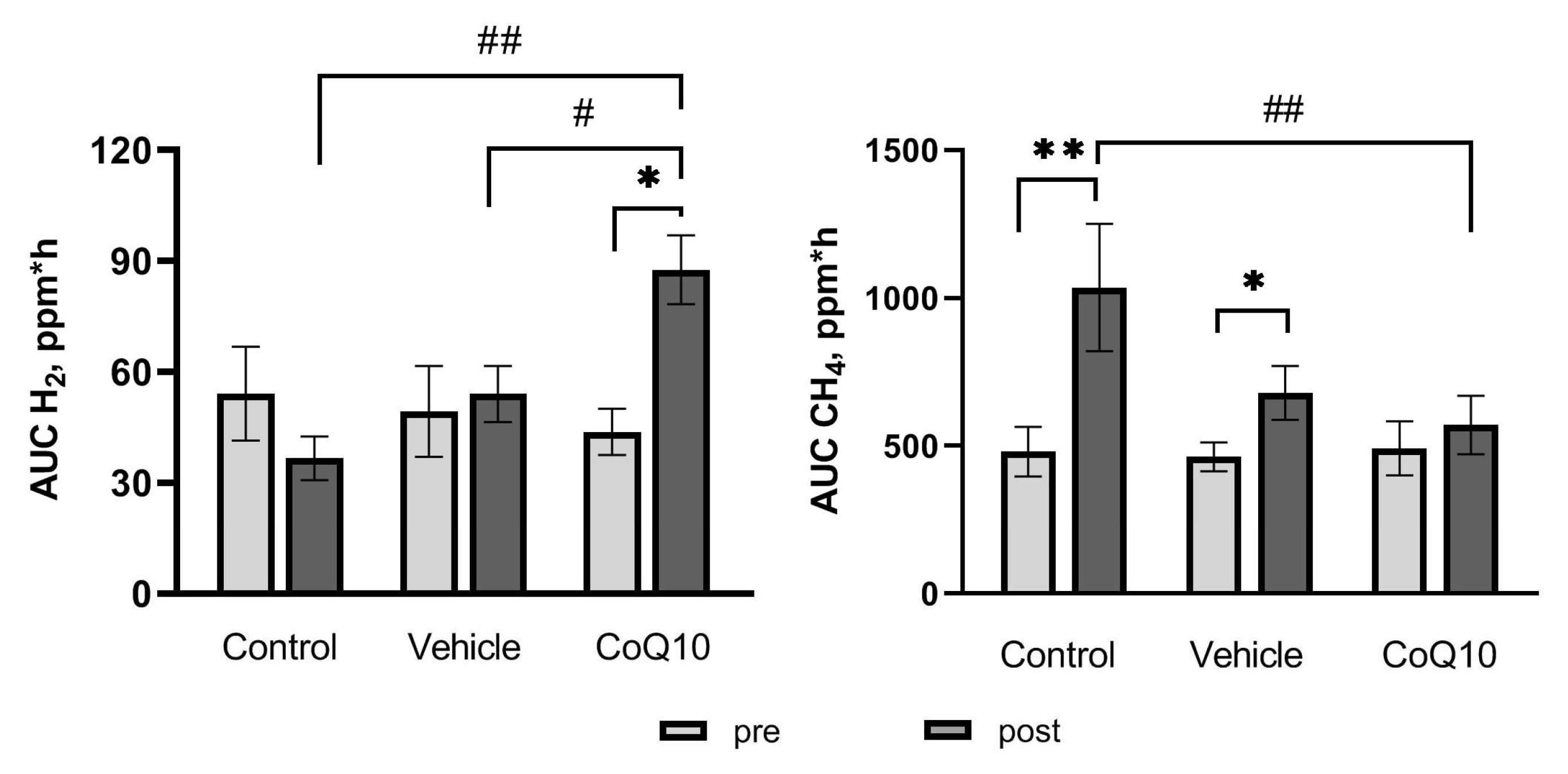
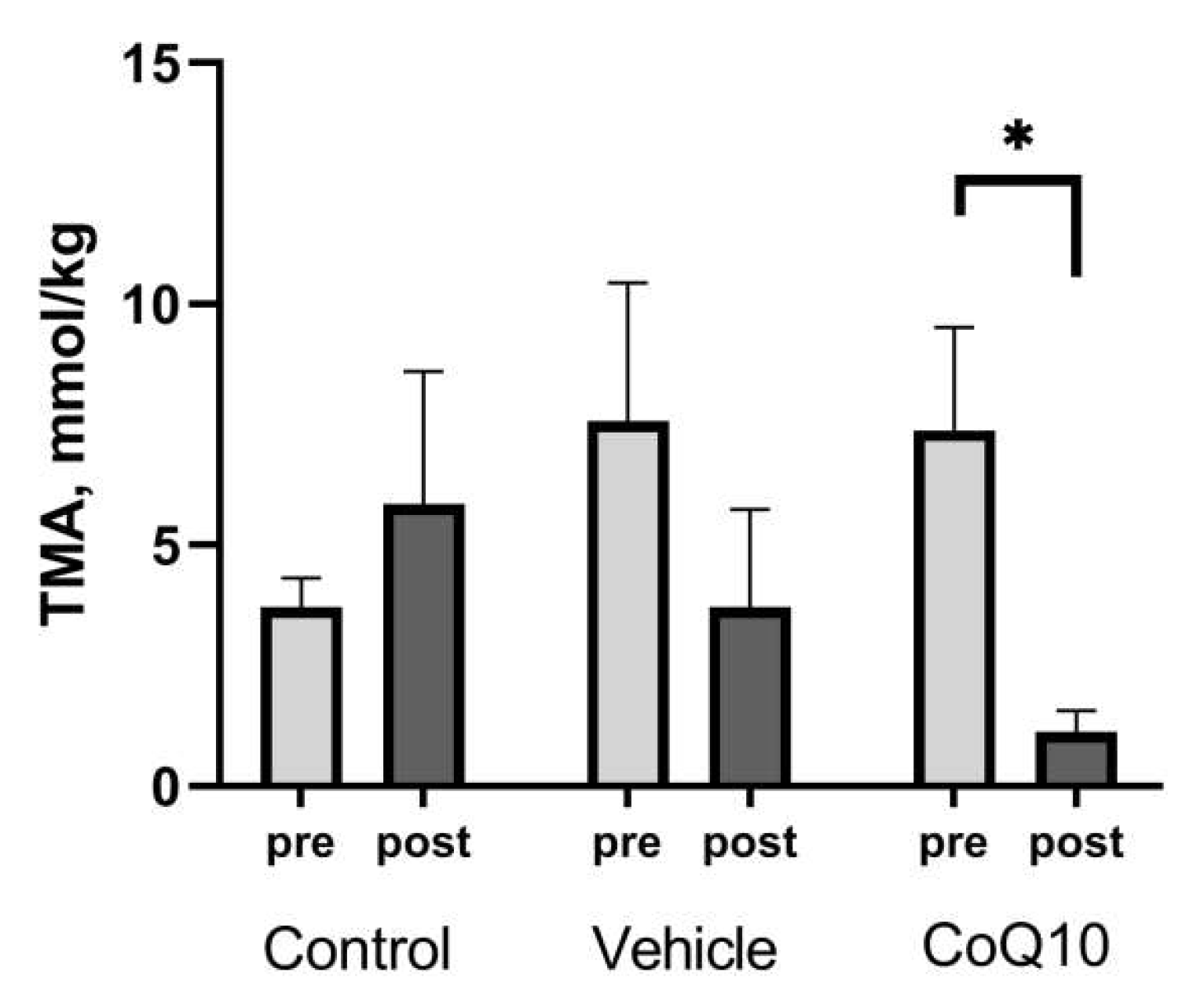
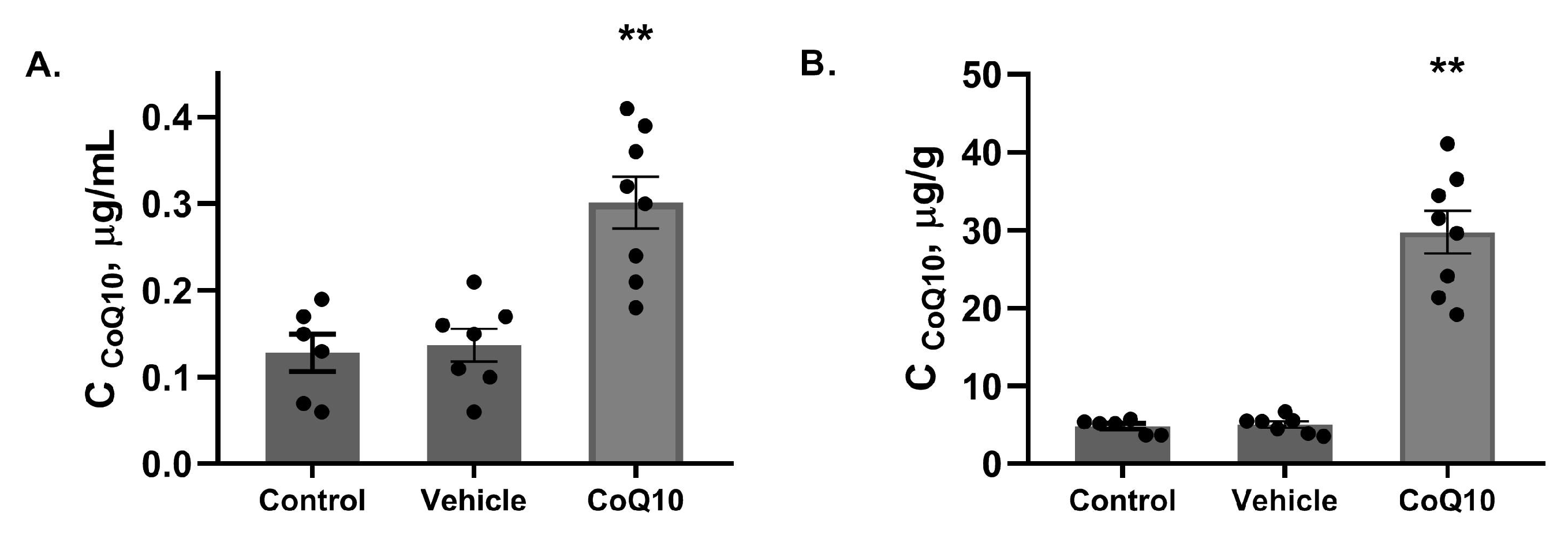
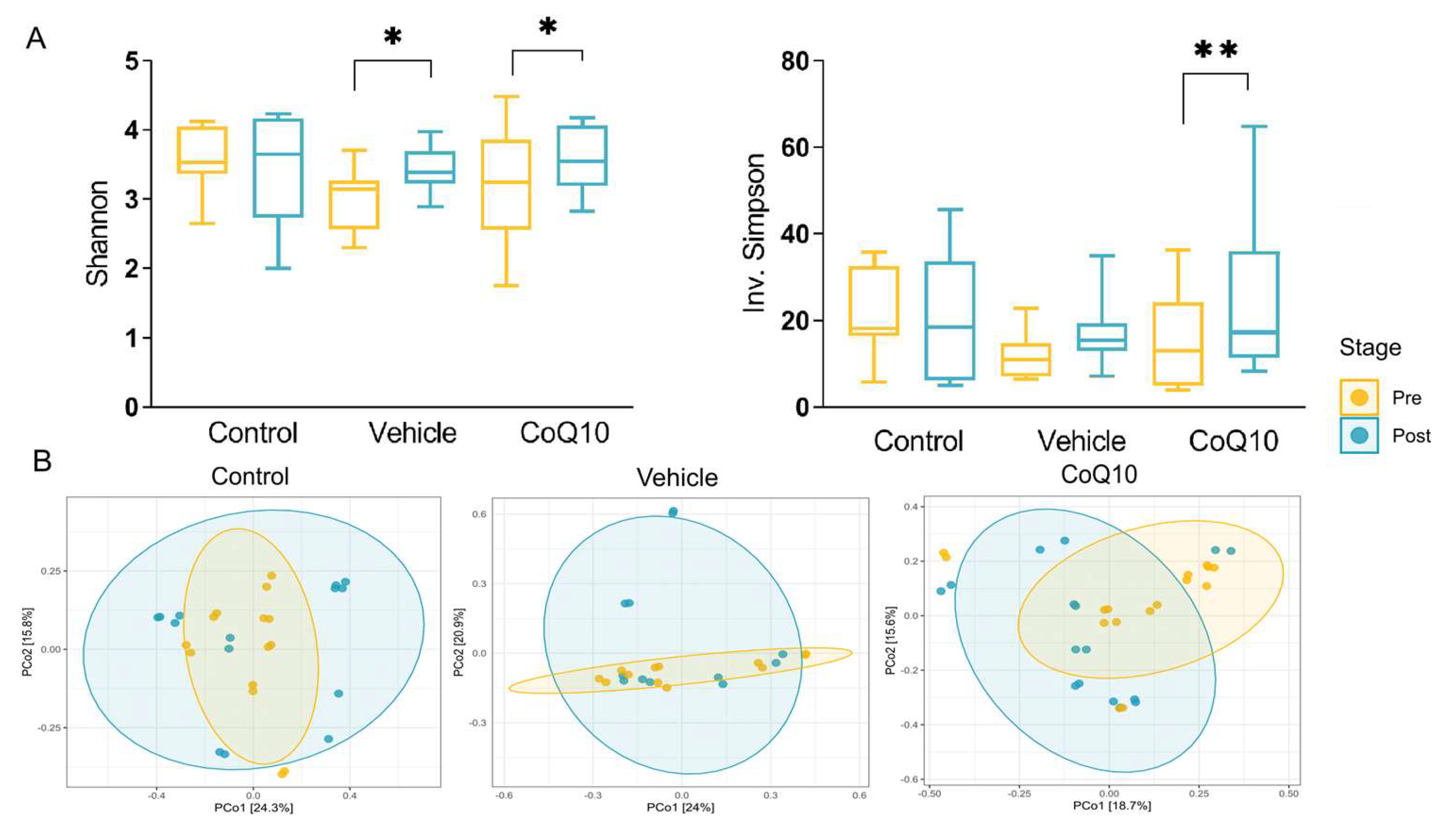


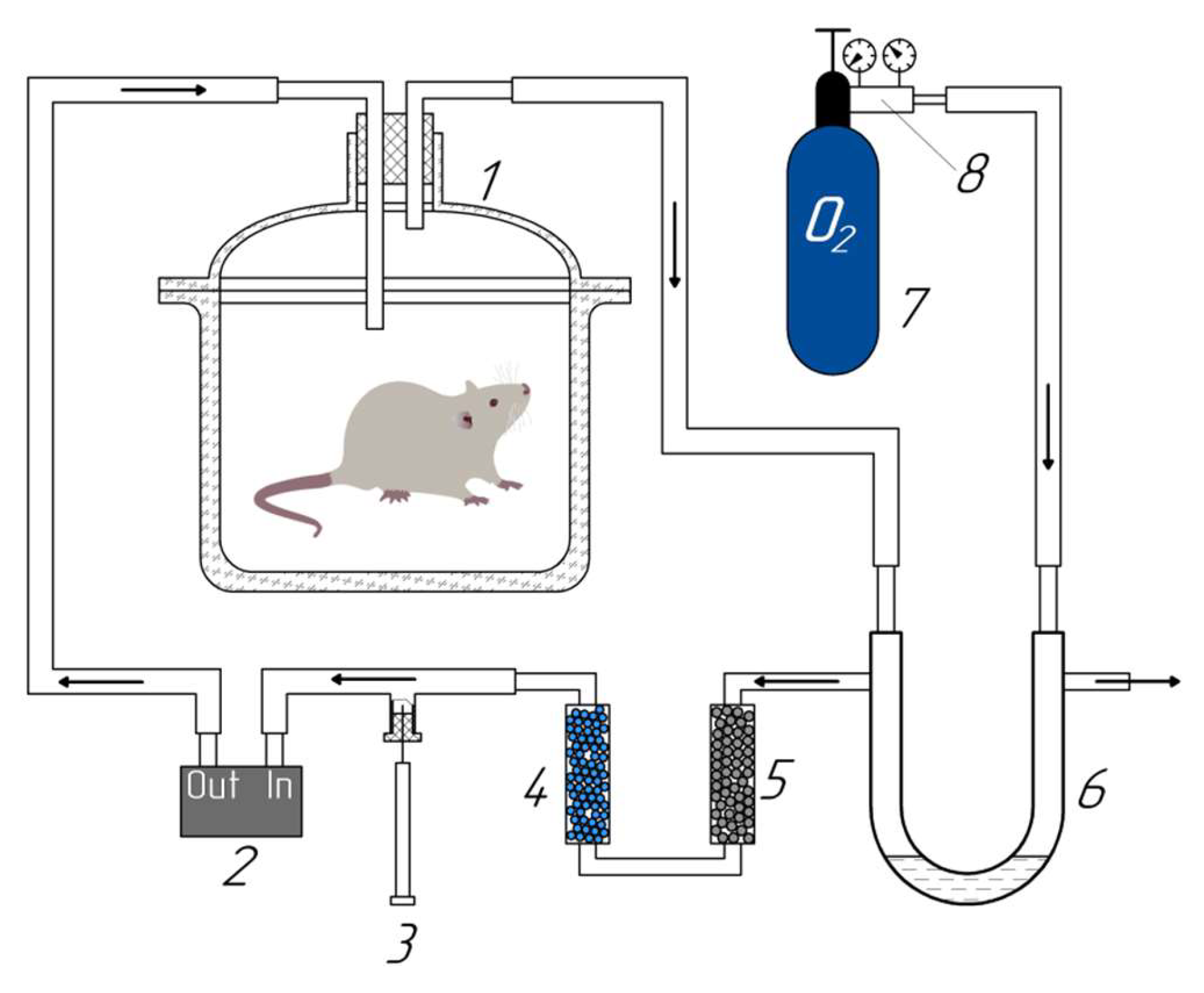
| Control | Vehicle | CoQ10 | |||||||
|---|---|---|---|---|---|---|---|---|---|
| Pre | Post | p-Value | Pre | Post | p-Value | Pre | Post | p-Value | |
| H2, ppm | 12.8 ± 2.2 | 11.8 ± 2.3 | 0.6 | 9.1 ± 3.2 | 9.2 ± 1.3 | 0.4 | 12.3 ± 2.6 | 13.6 ± 3.1 | 0.5 |
| CH4, ppm | 88.7 ± 9.5 | 96.5 ± 14.6 | 0.6 | 88.3 ± 14.0 | 74.5 ± 12.2 | 0.4 | 99.0 ± 15.7 | 92.7 ± 15.5 | 0.8 |
| CH4/H2 | 8.0 ± 1.8 | 12.4 ± 4.1 | 0.3 | 11.9 ± 1.9 | 9.2 ± 1.9 | 0.2 | 10.1 ± 2.4 | 5.9 ± 1.5 | 0.1 |
| Control | Vehicle | CoQ10 | ||||||||
|---|---|---|---|---|---|---|---|---|---|---|
| Pre | Post | p-Value | Pre | Post | p-Value | Pre | Post | p-Value | ||
| A. | Acetic acid, mmol/kg | 5.5 ± 1.5 | 5.7 ±1.2 | 0.8 | 3.9 ± 1.6 | 4.5 ± 1.7 | 0.8 | 4.9 ± 1.1 | 7.5 ± 1.8 | * 0.04 |
| Propionic acid, mmol/kg | 2.50 ± 0.81 | 2.62 ± 0.60 | 0.8 | 1.49 ± 0.66 | 1.73 ± 0.64 | >0.9999 | 2.29 ± 0.50 | 3.42 ± 0.75 | 0.09 | |
| Butyric acid, mmol/kg | 0.44 ± 0.12 | 0.49 ± 0.11 | 0.4 | 0.31 ± 0.15 | 0.36 ± 0.13 | 0.7 | 0.28 ± 0.06 | 0.63 ± 0.18 | * 0.04 | |
| Total SCFA, mmol/kg | 8.4 ± 2.4 | 8.8 ± 1.9 | 0.7 | 5.7 ± 2.4 | 6.6 ± 2.3 | 0.8 | 6.8 ± 1.6 | 11.1 ± 2.5 | * 0.02 | |
| B. | Acetic acid, μmol/L | 199 ± 21 | 215 ± 6 | 0.6 | 240 ± 19 | 235 ± 11 | 0.7 | 189 ± 22 | 246 ± 33 | 0.08 |
| Propionic acid, μmol/L | 27.2 ± 6.6 | 23.0 ± 6.7 | 0.4 | 34.3 ± 8.1 | 32.1 ± 7.8 | 0.4 | 30.7 ± 9.8 | 36,6 ± 9.8 | 0.4 | |
| Butyric acid, μmol/L | 8.9 ± 1.1 | 7.8 ± 1.9 | 0.6 | 8.4 ± 0.7 | 8.8 ± 1.0 | 0.7 | 7.0 ± 0.8 | 7.0 ± 0.6 | 0.98 | |
| Total SCFA, μmol/L | 233 ± 27 | 244 ± 8 | 0.7 | 282 ± 25 | 276 ± 18 | 0.7 | 227 ± 31 | 290 ± 43 | 0.1 | |
| Pre | Post | p-Value | |
|---|---|---|---|
| Control | 2.76 ± 0.41 | 6.26 ± 1.46 | ** p = 0.0017 |
| Vehicle | 5.20 ± 1.25 | 8.16 ± 1.71 | p = 0.09 |
| CoQ10 | 4.60 ± 0.76 | 3.93 ± 0.64 | p = 0.25 |
Disclaimer/Publisher’s Note: The statements, opinions and data contained in all publications are solely those of the individual author(s) and contributor(s) and not of MDPI and/or the editor(s). MDPI and/or the editor(s) disclaim responsibility for any injury to people or property resulting from any ideas, methods, instructions or products referred to in the content. |
© 2023 by the authors. Licensee MDPI, Basel, Switzerland. This article is an open access article distributed under the terms and conditions of the Creative Commons Attribution (CC BY) license (https://creativecommons.org/licenses/by/4.0/).
Share and Cite
Ivanova, A.Y.; Shirokov, I.V.; Toshchakov, S.V.; Kozlova, A.D.; Obolenskaya, O.N.; Mariasina, S.S.; Ivlev, V.A.; Gartseev, I.B.; Medvedev, O.S. Effects of Coenzyme Q10 on the Biomarkers (Hydrogen, Methane, SCFA and TMA) and Composition of the Gut Microbiome in Rats. Pharmaceuticals 2023, 16, 686. https://doi.org/10.3390/ph16050686
Ivanova AY, Shirokov IV, Toshchakov SV, Kozlova AD, Obolenskaya ON, Mariasina SS, Ivlev VA, Gartseev IB, Medvedev OS. Effects of Coenzyme Q10 on the Biomarkers (Hydrogen, Methane, SCFA and TMA) and Composition of the Gut Microbiome in Rats. Pharmaceuticals. 2023; 16(5):686. https://doi.org/10.3390/ph16050686
Chicago/Turabian StyleIvanova, Anastasiia Yu., Ivan V. Shirokov, Stepan V. Toshchakov, Aleksandra D. Kozlova, Olga N. Obolenskaya, Sofia S. Mariasina, Vasily A. Ivlev, Ilya B. Gartseev, and Oleg S. Medvedev. 2023. "Effects of Coenzyme Q10 on the Biomarkers (Hydrogen, Methane, SCFA and TMA) and Composition of the Gut Microbiome in Rats" Pharmaceuticals 16, no. 5: 686. https://doi.org/10.3390/ph16050686
APA StyleIvanova, A. Y., Shirokov, I. V., Toshchakov, S. V., Kozlova, A. D., Obolenskaya, O. N., Mariasina, S. S., Ivlev, V. A., Gartseev, I. B., & Medvedev, O. S. (2023). Effects of Coenzyme Q10 on the Biomarkers (Hydrogen, Methane, SCFA and TMA) and Composition of the Gut Microbiome in Rats. Pharmaceuticals, 16(5), 686. https://doi.org/10.3390/ph16050686








